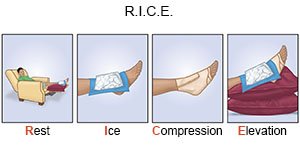Salter-Harris Fracture
Medically reviewed by Drugs.com. Last updated on Apr 6, 2025.
A Salter-Harris fracture is a break in your child's bone that goes through a growth plate. Growth plates are tissue that forms new bone on the ends of certain bones to make them longer as your child grows. Examples include thigh bones, forearm bones, and finger bones. When your child is finished growing, the growth plates will harden and become solid bone. Some Salter-Harris fractures take up to 14 days before they can be seen on an x-ray. Your child's injury may need to be put in a cast or splint if a Salter-Harris fracture is known or suspected. This will help prevent more injury to the growth plate and surrounding bone.
 |
DISCHARGE INSTRUCTIONS:
Return to the emergency department if:
- Your child's pain gets worse, even with medicine.
- The skin under your child's cast or splint is tingling or numb.
- Your child can no longer move his or her fingers or toes.
Call your child's doctor or bone specialist if:
- Your child has a fever.
- Your child says his or her cast or splint feels too tight.
- You see swelling below the splint or cast.
- Your child's cast is cracked or has soft spots.
- You have questions or concerns about your child's condition or care.
Medicines:
- Prescription pain medicine may be given. Ask your child's healthcare provider how to give this medicine safely. Some prescription pain medicines contain acetaminophen. Do not give your child other medicines that contain acetaminophen without talking to his or her healthcare provider. Too much acetaminophen may cause liver damage. Prescription pain medicine may cause constipation. Ask your child's healthcare provider how to prevent or treat constipation.
- Do not give aspirin to children younger than 18 years. Your child could develop Reye syndrome if he or she has the flu or a fever and takes aspirin. Reye syndrome can cause life-threatening brain and liver damage. Check your child's medicine labels for aspirin or salicylates.
- Give your child's medicine as directed. Contact your child's healthcare provider if you think the medicine is not working as expected. Tell the provider if your child is allergic to any medicine. Keep a current list of the medicines, vitamins, and herbs your child takes. Include the amounts, and when, how, and why they are taken. Bring the list or the medicines in their containers to follow-up visits. Carry your child's medicine list with you in case of an emergency.
How to care for your child:
 |
- Rest may help your child's fracture heal, and help manage pain. Help your child rest often during the day.
- Elevate the area above the level of your child's heart, as often as possible, for 1 to 3 days. Your child may lie back in a bed or chair and put pillows under an injured leg or foot. Use pillows to prop up the area. Your child should wiggle his or her fingers and toes often to keep blood flowing.
- Ice helps decrease pain and swelling. Put crushed ice in a plastic bag and cover it with a towel. Place the ice over the cast or splint for as long and as often as your child's healthcare provider says you should.
How to care for your child's cast or splint:
- Keep the cast or splint dry. Use 2 layers of plastic or waterproof shields to keep the splint or cast dry when your child bathes.
- Keep powder, dirt, and sand out of the cast or splint.
- If your child has a leg cast, ask when it is safe for him or her to walk on it.
- Do not pull out the padding or break off hard edges of the cast.
- Do not let your child use coat hangers or other sharp objects to scratch the skin under the cast.
How to prevent sports injuries:
- Take your child for regular checkups as directed. Ask your child to tell you when he or she is hurt. Regular checkups may catch unknown injuries before they get worse.
- Have your child do different exercises. Your child should not do the same exercises or drills every day.
- Teach your child to play safely. Make sure your child competes with other children of the same size, fitness level, and skill.
- Have your child rest during sports activities as directed. Rest periods are needed during sports training. If your child is injured, he or she may need to avoid contact sports for 4 to 6 months to prevent another injury.
Follow up with your child's doctor as directed:
Your child may need to have the fracture checked each week as it heals. Ask how often your child needs to see his or her healthcare provider or bone specialist. Write down your questions so you remember to ask them during your visits.
© Copyright Merative 2025 Information is for End User's use only and may not be sold, redistributed or otherwise used for commercial purposes.
The above information is an educational aid only. It is not intended as medical advice for individual conditions or treatments. Talk to your doctor, nurse or pharmacist before following any medical regimen to see if it is safe and effective for you.
Learn more about Salter-Harris Fracture
Care guides
Further information
Always consult your healthcare provider to ensure the information displayed on this page applies to your personal circumstances.
